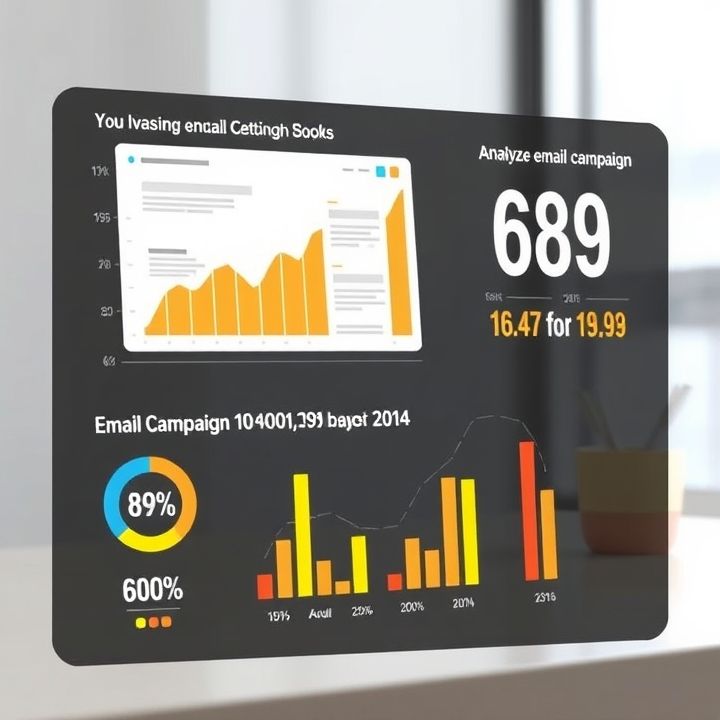Table of Contents
- Introduction
- Understanding the Importance of Customer Segmentation
- Different Methods of Segmenting Customers
- Collecting and Analyzing Customer Data
- Creating Targeted Buyer Personas
- Crafting Personalized Email Content
- Automating Email Campaigns Based on Segments
- Measuring the Effectiveness of Segmented Email Campaigns
- Continuous Improvement through A/B Testing and Feedback
- Conclusion
- Frequently Asked Questions
Introduction
Are your email marketing campaigns falling flat? Discover how customer segmentation can ignite your email engagement like never before! Imagine sending personalized, highly-relevant emails to segmented groups of customers, boosting your open rates, click-through rates, and conversions exponentially.
Why is customer segmentation so crucial? Let’s break it down:
| Unsegmented Campaigns | Segmented Campaigns |
|---|---|
| Generic content that may not resonate | Tailored messages that connect on a personal level |
| Lower open and click rates | Higher engagement due to relevancy |
| High unsubscribe rates | Improved customer loyalty |
See the difference? Mastering customer segmentation brings you closer to your customers, fostering relationships that convert into sales. Intrigued? Good! There’s so much more to uncover about these game-changing strategies.
Understanding the Importance of Customer Segmentation
Understanding the importance of customer segmentation is crucial for businesses aiming to deliver highly targeted and relevant content, especially in email marketing. Customer segmentation involves dividing a customer base into distinct groups that share similar characteristics such as demographics, behavior, and preferences. By doing so, companies can create personalized marketing strategies that cater specifically to the needs and interests of each segment.
One of the primary benefits of customer segmentation is the ability to improve engagement rates. When customers receive content that resonates with them, they are more likely to interact with it, leading to higher open and click-through rates in emails. Furthermore, segmentation allows businesses to optimize their allocation of resources. Instead of adopting a one-size-fits-all approach, companies can focus their efforts on the segments that are most likely to convert, thus achieving a higher return on investment.
Additionally, effective segmentation can enhance customer loyalty. By consistently providing valuable and relevant content, businesses can build stronger relationships with their customers, fostering trust and long-term loyalty. Understanding and leveraging customer segmentation is therefore a key strategy for any business looking to maximize the impact of its email marketing campaigns.
Different Methods of Segmenting Customers
There are several methods of segmenting customers to deliver highly targeted and relevant content in emails. One common approach is demographic segmentation, where customers are divided based on age, gender, income, education, and other demographic factors. Another method is geographic segmentation, which focuses on customers’ physical locations such as country, region, or city. This can be especially useful for businesses that operate in multiple areas.
Behavioral segmentation takes into account customers’ purchase behaviors, usage patterns, and brand interactions. By analyzing how customers interact with your products or services, you can tailor your email content to better meet their needs. Additionally, psychographic segmentation considers customers’ lifestyles, values, and interests. This approach allows you to create more personalized and engaging content that resonates with your audience’s beliefs and preferences.
Another effective method is firmographic segmentation, which is particularly useful for B2B marketing. This involves categorizing customers based on industry, company size, and revenue. Finally, occasion-based segmentation targets customers based on specific times or events, such as holidays, birthdays, or anniversaries. By leveraging these various methods, businesses can effectively reach different customer segments with highly relevant email content.
Collecting and Analyzing Customer Data
Collecting and analyzing customer data is critical for executing effective customer segmentation and delivering highly targeted content in emails. The process begins with gathering data through various channels such as website activity, purchase history, and social media interactions. It is important to use tools like CRM software and analytics platforms to compile and manage this data efficiently.
Once collected, the next step is to analyze the data to identify patterns and trends. Segmentation can be based on diverse factors such as demographics, behavior, and customer preferences. Advanced techniques like predictive analytics and machine learning can also be employed to uncover deeper insights.
This detailed analysis enables marketers to create highly relevant and personalized content that resonates with different customer segments. Whether it is a special offer or a tailored product recommendation, the goal is to ensure that the content speaks directly to the needs and interests of each segment. By doing so, marketers can improve email engagement rates and ultimately drive higher conversion rates.
Creating Targeted Buyer Personas
Creating targeted buyer personas is crucial for delivering highly relevant and personalized content in your emails. A buyer persona is a semi-fictional representation of your ideal customer based on market research and real data about your existing customers. Start by gathering information on demographics, behavior patterns, motivations, and goals. This can involve surveys, interviews, and analyzing your customer data.
Next, segment your personas based on common characteristics such as age, location, purchasing behavior, and interests. Tailor your email content to address the specific needs and pain points of each segment. For instance, a persona interested in budget-friendly options should receive promotions for sales and discounts, while a persona looking for premium products might appreciate detailed information on product quality and unique features.
Using segmentation and targeted buyer personas ensures that your content resonates with your audience, increasing engagement and conversion rates. Continually update and refine your personas as you collect more data to keep your email marketing strategy effective and relevant.
Crafting Personalized Email Content
Crafting personalized email content is essential to enhance user engagement and drive conversions. The foundation of personalized emails lies in effective customer segmentation. By dividing your audience into distinct groups based on demographics, interests, behavioral data, and purchase history, you can tailor content that resonates with each segment. Employing a combination of dynamic content and personalized subject lines, you can ensure that the emails feel more relevant to the recipients.
Additionally, using personalization tokens such as the recipient’s name, recent interactions, or recommended products can make the content feel highly individualized. It’s crucial to continually test and analyze the performance of different content types and segmentation strategies through A/B testing. By monitoring open rates, click-through rates, and conversion rates, you can refine your approach for optimal results. Remember, the goal is to create valuable and engaging experiences that meet the specific needs and preferences of each customer segment.
Automating Email Campaigns Based on Segments
Automating email campaigns based on segments can dramatically enhance the efficiency and effectiveness of your marketing efforts. By categorizing your audience into distinct segments according to demographics, behavior, purchase history, or engagement levels, you can send highly personalized and relevant content to each group. This targeted approach increases the likelihood of your emails being opened and acted upon.
The first step is to gather and analyze data to identify these segments. Once you have your segments defined, you can use automation tools to design and schedule email campaigns tailored to the unique needs and preferences of each group. For instance, new subscribers might receive a series of welcome emails, while loyal customers could be alerted to exclusive offers or updates.
Leveraging segmentation helps to ensure that recipients receive content that is directly relevant to them, which can lead to higher engagement rates, increased customer satisfaction, and ultimately, better return on investment. Automation streamlines this process, making it more manageable to deliver timely and appropriate messages without the need for constant manual intervention.
Measuring the Effectiveness of Segmented Email Campaigns
Measuring the effectiveness of segmented email campaigns is crucial for refining your marketing strategy and achieving better results. One of the primary metrics to track is the open rate, which indicates how many recipients opened your email. A high open rate suggests that your subject lines and sender information are compelling. Another important metric is the click-through rate (CTR), which shows the percentage of people who clicked on links within your email. This helps gauge the relevance and engagement level of your content.
Additionally, the conversion rate measures the percentage of recipients who completed a desired action, such as making a purchase or filling out a form, after clicking a link in your email. Understanding the bounce rate is also essential, as it reveals the percentage of emails that couldn’t be delivered to subscribers. A high bounce rate can indicate issues with your email list quality.
Customer feedback and unsubscribes should not be overlooked; they provide valuable insights into how your audience perceives your emails. By regularly analyzing these metrics, you can fine-tune your email campaigns to better meet the needs and preferences of your segmented audiences, thereby improving overall performance.
Continuous Improvement through A/B Testing and Feedback
To achieve continuous improvement in your email campaigns, leveraging A/B testing and collecting feedback from recipients are crucial steps. A/B testing, also known as split testing, involves sending two variations of an email to different segments of your audience to determine which one performs better. By analyzing these results, marketers can identify what works best in terms of subject lines, content, design, and call-to-action strategies.
Feedback can be gathered through direct responses, surveys, or engagement metrics such as open rates and click-through rates. This feedback provides valuable insights into customer preferences and behaviors. Implementing these insights allows for the refinement of future email campaigns, ensuring they are more relevant and engaging for the audience.
Utilizing both A/B testing and feedback not only enhances the effectiveness of your emails but also fosters a culture of continuous improvement within your marketing team. This iterative process ensures that your email strategies remain dynamic and aligned with the evolving needs and preferences of your target audience.
Conclusion
In conclusion, mastering customer segmentation is essential for any business looking to unlock explosive email engagement. By understanding the importance of segmentation and employing various methods to categorize your audience—be it by demographics, behavior, or purchase history—you can craft highly personalized and relevant content. Utilizing tools and techniques such as CRM software, predictive analytics, and A/B testing ensures your emails not only reach the right people but also resonate with them.
Automating email campaigns based on these segments further enhances efficiency, allowing you to deliver timely messages without constant manual effort. By continually measuring the effectiveness of your campaigns through key metrics like open rates and conversion rates, and making adjustments based on feedback, you can achieve continuous improvement and better results. Ultimately, a well-executed customer segmentation strategy will lead to higher engagement rates, increased customer loyalty, and a stronger return on investment.

